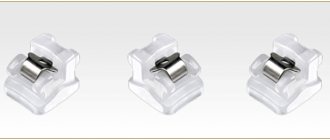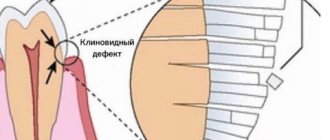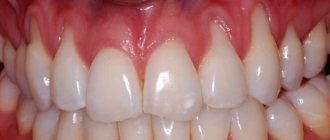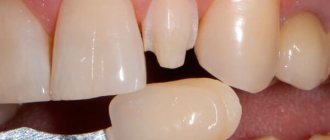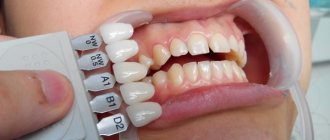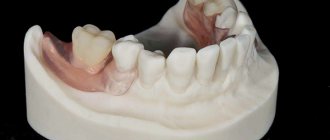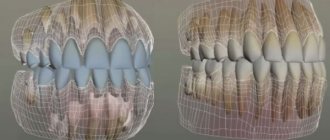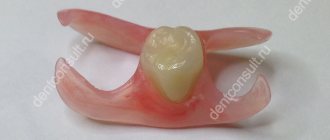It’s amazing how much a beautiful smile with straight, white teeth influences a person’s appearance and relaxedness. Of course, not everyone can boast of such luxury - some have naturally not very white teeth, others were unable to maintain the integrity of their dentition. And in this case they can come to the rescue Lumineers - they can be installed at any age (we are, of course, only talking about adults), and the price of the issue is not comparable to the cost of other methods, especially when you consider how long the pads will last.
What are Lumineers? These are very thin ceramic plates used as onlays on teeth. Their thickness is almost less than that of contact lenses, and after installation they are not felt at all.
Lumineers are often compared to veneers. Is there a difference between them? Yes, and it is quite significant - lumineers are thinner and therefore do not require preliminary grinding of the teeth. But the minimum thickness should not confuse you - in fact, lumineers are very durable, as they are made from a special composite material with the addition of crystals, making it resistant to external factors - food, exposure to a toothbrush, and so on.
Lumineers - characteristics
The installation of lumineers is one of the most delicate, gentle and reliable tooth protection and reconstruction. Their use allows you to hide such dental imperfections as minor chips of the enamel, its darkening, pits or cracks and the presence of dental erosion. Product characteristics:
- Lumineers are made 0.2–0.3 mm thick, whichever does not exceed the thickness of the eye lens;
- the resulting prosthesis best matches the shape of the tooth in need of reconstruction and its natural color;
- the strength of the structure allows you to avoid the appearance of microcracks on its surface;
- This product has a long service life, which is equal to 20 years of operation;
- If necessary, lumineers can be easily removed without compromising the integrity of tooth enamel.
The production of lumineers takes place in laboratory conditions. The American company DenMat is engaged in the performance of these products. Installation can only be carried out by specialists who have completed training courses and relevant internships at the manufacturer.
Manufacturer
Lumineers have been used in dentistry for more than two decades, but in Russia they have gained popularity since 2005. The manufacturer and patent holder of the production technology is the American company Cerinate.
Lumineers are made from ceramic with the addition of crystalline leucite, which gives the material excellent aesthetic characteristics. It does not contain metallic inclusions, which eliminates even the slightest reflection of light in the microprosthesis. Light can circulate and penetrate the adjustment freely, just like natural enamel. It is no coincidence that leucite is often used in jewelry making.
Ceramics for overlay lumineers, produced using Cerinate technology, are not only beautiful, but also have great mechanical strength. Original products are not susceptible to chipping or cracking, which ensures a long service life.
On a note!
The full composition and details of the technological process for producing “Hollywood ceramics” are kept secret.
Installation Features
Lumineers are installed only on the front teeth from the outside. Attachment to tooth enamel occurs using special strong dental cement. Its peculiarity is to resist the aggressive effects of consumed food and saliva for a long period of time. Thanks to the latest technologies, cement is saturated with a high fluorine content. This has a beneficial effect on tooth enamel, strengthening it while wearing dentures.
Despite the fact that this design can last for many years, many patients are concerned about this issue. What will happen to my teeth if I need to remove lumineers? This structure is easily removed from the surface of tooth enamel using a special tool, without violating its integrity or causing damage to the enamel. This is due to a special procedure for installing dentures, which takes place without grinding the tooth enamel, which cannot be done when installing conventional veneers.
For many patients, another important feature of installing prostheses is that during the procedure there is no need to use a drill or use anesthetic injections.
How is lumineers installed?
The entire installation process contains 2-3 steps. To install lumineers, you will first have to carry out a complete treatment of the entire oral cavity: cure possible inflammatory processes, fill existing teeth defects, eliminate caries. This entire preparatory stage is not included in the cost of the procedure for installing lumineers. Next, after complete sanitation of the oral cavity, the process of installing dentures takes place in the following sequence:
- Impressions are made of both jaws;
- using a special computer program, a smile simulation is created;
- all data is sent to the laboratory where the porcelain onlay will be manufactured;
- The fitting of the product and its installation is carried out already during the second visit to the doctor, but only if all the onlays fit perfectly to the patient’s teeth.
A strong connection of the prosthesis with the tooth surface makes it possible to avoid carious destruction. The tight-fitting onlay prevents harmful microorganisms and bacteria from entering the dental tissues.
Kinds
The manufacturing company Cerinate produces 2 types of lumineers, which differ in the manufacturing method. Original onlays are made from individual impressions: the doctor takes an impression of the teeth being restored and sends it to a laboratory located in America.
The finished lumineer arrives in Russia by mail and is a unique product made in full accordance with the anatomical features of the oral cavity of a particular patient. Such onlays have a high degree of wearing comfort and very accurately follow the contours of natural teeth.
Duo PCH dental lumineers are also Cerinate products, made on the basis of proprietary ceramics, but onlay templates are already available in the Russian clinic. This type of prosthesis appeared relatively recently and has the advantage of a shorter production time. That is, you will not have to wait for the impressions to be sent and receive the goods by mail - the entire process will take place directly at the Russian medical institution.
Important!
There are only two brands of original lumineers - Cerinate and Duo PCH. They have no other names.
Advantages and possible disadvantages of installing lumineers without refining?
If we compare the installation of lumineers with the installation of conventional crowns or veneers, the former have significant advantages:
- no procedure for grinding the tooth, which allows maintaining the integrity of the enamel;
- a minimum number of visits to the dental office, which saves financial costs for each individual appointment;
- painlessness of the procedure;
- no need to install temporary overlays;
- the product cannot be stained with natural or artificial dyes, for example, from drinking coffee, tea, berries, etc.;
- the pads are absolutely safe for the patient’s health;
- do not contribute to the formation of dental caries, but on the contrary, prevent its development;
- it is possible to remove the structure;
- long service life;
- no discomfort when wearing.
Speaking about the disadvantages of lumineers, we can note the high cost of the product. Also, such onlays can visually increase the volume of the tooth. This is due to the fact that during installation the enamel is not turned. This defect will be less noticeable on the patient’s small teeth.
Contraindications
There are contraindications for this method. There are few of them:
- Caries. Before installing lumineers, it is necessary to cure carious teeth.
- Severe crooked teeth.
- Bruxism.
- Periodontitis.
- Very thin enamel.
- Malocclusion.
Sometimes it happens that jaws with inserted plates become larger and more massive. They have to be adjusted, resulting in gum inflammation and bleeding.
There are a number of fakes. Therefore, you need to be careful not to overpay. But this only happens with such records. Because they are not produced in our country, but are ordered abroad. Hence the high cost.
An experienced doctor will help you make the right choice and install the plates efficiently. Therefore, finding a good clinic and a professional in this matter is of no small importance. Although porcelain plates are an expensive pleasure. But for some people, a beautiful look and a dazzling smile are worth more than the money spent on it.
In what cases is it recommended to install?
Indications for the installation of lumineers may include:
- The presence of erosion on tooth enamel. Lumineers installed on the front teeth will help hide such changes.
- The teeth have minor chips or their surface has worn away.
- The enamel has changed color or become stained;
- For minor tooth curvatures. Crowns installed for this problem will help visually level it.
- The presence of defects in the form of tremata or diastemas.
- There are crowns on the front teeth that the patient wants to hide.
- Teeth that have been affected by fluorosis.
- There are fillings on the incisors that have changed their color due to the statute of limitations, but are still intact.
- large interdental spaces.
Lumineers without grinding can hide or correct only minor defects. In case of significant violations, they are powerless. Contraindications for installation may include: periodontitis, caries, severe curvature of the incisors, various bite pathologies, bruxism or pathological abrasion of tooth enamel. Although many of these problems can be successfully treated, after which lumineers can be placed.
Some questions that concern patients
Is it possible to install lumineers on so-called dead teeth? Unlike veneers, lumineers can replace traditional crowns.
Is it possible to install onlays if crowns are already installed? Lumineers are installed on crowns, but only when the latter are in excellent condition.
Is it possible to combine ceramic and porcelain onlays? Lumineers, which are made of porcelain, are placed on the front incisors. To save on restoration costs, onlays made of zirconium can be installed on chewing incisors.
Description
Lumineers are super-thin veneers that are bonded to the front surface of your teeth. They consist of porcelain or ceramics.
The details of lumineers contour to the shape of the tooth, hiding irregularities in the enamel. They are applied so that the cutting part of the tooth is covered.
Their thickness can be compared to eye lenses. In addition, Lumineers do not require grinding of the surface of the teeth, similar to veneers. In terms of strength, they are not inferior to metal-ceramic crowns.
With the help of lumineers you can truly achieve the perfect smile. Let's watch the following video:
Do Lumineers require special care?
Lumineers do not require any special operating requirements. The patient can consume all foods and drinks without fear. These pads withstand food coloring well without changing their color. The strength of the material used allows you to eat harder foods without chopping them first. An exception would be opening bottles and nuts with your teeth.
If we talk about special care, hygiene procedures are carried out 2 times a day using the usual method of brushing teeth. Also, after eating, you should rinse your mouth with warm water.
Cost of this service
The price of lumineers is quite high - $1000 per unit of product. This is determined by the completion of the work and the cost of delivery of the product.
Not every dental specialist will be able to carry out the installation procedure efficiently, and not everyone has sufficient knowledge in this area. When turning to a doctor with such a request, you need to make sure how much his professionalism meets the requirements of the procedure performed. Incorrect installation of onlays will lead to spoiled appearance of teeth and the development of diseases. This happens due to the formation of small cracks, which become a haven for bacteria and the accumulation of dental plaque.
If we talk about manufacturing, it is produced only in the USA using special ceramics using patented technology. The cost of the overlays includes delivery of the goods. The first thing that should alert a patient when choosing a dental clinic and specialist is when such a service costs less than $700.
Sources used:
- "Glossary of Dental Clinical and Administrative Terms"
- Optimization of dental restoration with ceramic inlays / Ziliya Chaika, Galina Ivanovna Ron. - M.: LAP Lambert Academic Publishing, 2012.
- Orthopedic treatment of pathological abrasion of hard dental tissues / Kh.A. Kalamkarov. — M.: Medicine
Methods for making ceramic veneers
The emergence of new methods for manufacturing orthopedic structures is directly related to the widespread use of computer technology. In modern dental laboratories, three methods are used in the manufacture of ceramic onlays.
- Layer-by-layer application. Microprostheses are made on platinum foil (0.025 mm): it is pressed around a plaster model of a tooth already prepared for prosthetics to obtain an exact shape, then ceramic mass is applied to the foil and the mold is fired in an oven. The model may not be plaster, but fireproof, then the process is simplified: the ceramic mass is applied not to foil, but directly to the tooth model, and fired on it. This allows you to reduce shrinkage and avoid possible distortions. And the cost of the veneer will be lower - after all, expensive foil will not be needed.
- Casting or injection molding. Veneer overlays are modeled from wax onto working models and packaged in a special fire-resistant mass. Under the influence of high temperature, the wax melts, and a frame is formed from the softened ceramic block. The finished porcelain overlays are painted in the appropriate color. The popularity of the technique is due to its simplicity; the veneers are accurate and fit well to the edge of the tooth.
- Milling (CAD/CAM). This is the most progressive method - computer modeling occurs using CAD/CAM technologies. The main advantage of the method is that veneer microprostheses can be manufactured and installed in one visit. Milling the overlay takes no more than ten minutes. Then the structure is polished, glazed and fixed on the outside of the tooth. The process algorithm is very simple: the doctor makes an optical impression of a tooth already prepared for prosthetics, sends the virtual model by e-mail to the laboratory, where a ceramic onlay is made and sent to the clinic by courier.
